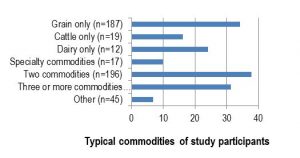Overview
Despite the large size of the agricultural workforce and the elevated prevalence of musculoskeletal pain compared to other industries, only a small number of studies have examined associations between agricultural activities and musculoskeletal pain. Inferences from these studies are limited by several methodological weaknesses. Our study of musculoskeletal pain among farmers obtains information every six months (Spring 2012 through Spring 2015) using questionnaires completed by farmers in IL, IA, KS, MN, MO, NE, ND, SD, WI). The questionnaires allow us to track (over time) information about demographics, personal health (including musculoskeletal pain), occupational psychosocial stress, farm characteristics, and farm-related tasks and equipment. In addition, we also travel to several participating farm operations to obtain direct measures of exposure to physical risk factors for musculoskeletal pain, such as working postures, muscle activity levels, and vibration (during use of vehicles). Combining the questionnaire information with the measured exposure information will allow us to better characterize associations between agricultural activities and musculoskeletal pain and provide a robust evidence-base from which to design future interventions.
Relevance
Musculoskeletal pain is a common work-related health outcome among famers. As many as 80% report musculoskeletal pain in any body area during the previous year, and nearly 50% reporting low back pain, specifically, during the previous year.[1]
This research study will determine more precise associations between agricultural work and musculoskeletal pain by using direct measures of physical work hazards. Prospective observation of a large number of agricultural workers provides a strong and direct study design that will provide a more complete understanding of associations between exposure to physical risk factors and musculoskeletal symptoms among agricultural workers. This study will also provide information about seasonal trends in participants’ musculoskeletal symptom experience. Moreover, we expect the proposed research to provide an evidence base for the development of new intervention strategies to reduce the number and severity of musculoskeletal outcomes among this large population of workers.
[1] Osborne A, Blake C, Fullen BM, Meredith D, Phelan J, McNamara J, Cunningham C. 2012. Prevalence of musculoskeletal disorders among farmers: a systematic review. American Journal of Industrial Medicine, 55:143-158.
Study Progress
Questionnaires
We enrolled 518 subjects at baseline for this study. The study participants are slightly older, have a higher income and greater number of acres of land than the representative population comprising the nine states of the Great Plains Region. Of these 518, 493 (4.8%) were not eligible to participate in the follow-up portion due to farming status (i.e. no longer farming, etc.) . We have completed five rounds of follow-up questionnaires with response rates averaging about 68%.
Representation of the location of the 518 participants in the study (above).
Data from the baseline questionnaire shows the types of commodities study participants produce (below).

Physical Work Load Measures
We have also completed about 60% of the on-farm measures of physical work exposure. These measures have been conducted on farms in Iowa, Minnesota, Wisconsin, Illinois, and Missouri. The farms are representative of a variety of production commodities including dairy, beef cattle, hogs, horses, poultry, sheep, goats, corn, soybeans, hay, alfalfa, poultry, tree harvesting, specialty items (heirloom seeds), specialty poultry, etc. During the farm visits, an inventory of farm equipment that is used is conducted.
